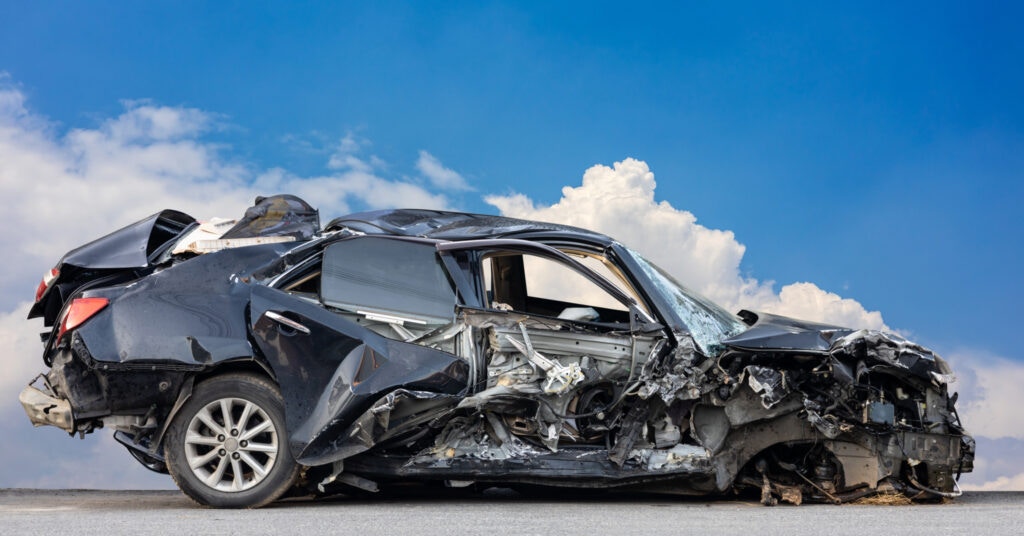Cat A, B, S and N explained
You may have heard about written-off cars, but what exactly does that mean?
Cars that are ‘written off’ have been involved in an accident of some sort and deemed by an insurance company as either unsafe to ever be on the road again, or uneconomical to repair – i.e., the cost to repair the damage is 50% or more of the vehicle’s current valuation. This can include damage to the car’s exterior, motor, chassis, or other parts.
The damaged vehicle will be given a label by the insurer depending on the severity of the accident. There are now four insurance categories for damaged cars, AKA category write-offs: Cat A, B, S, and N. Cat S used to be known as Cat C, and Cat N used to be known as Cat D.
Read on to learn how to sell your car, or scrap them, and all your options as an owner of a category write-off vehicle.
| Label | Definition | Outcome |
| Cat A | The vehicle is beyond repair, never to be driven again, and can’t be sold as parts | The vehicle is crushed and scrapped at an ATF (authorised treatment facility) |
| Cat B | The vehicle is beyond repair, never to be driven again, but some parts e.g. the gearbox may be stripped and sold | The vehicle shell is crushed and scrapped at an ATF |
| Cat S (formerly Cat C) | The vehicle sustained serious structural damage, but can be repaired and driven | The cost of repair may outweigh the value of the vehicle, but destruction is not enforced |
| Cat N (formerly Cat D) | The vehicle sustained cosmetic or very minor, repairable damage | The vehicle should be repaired by a licensed mechanic, and proof of service history should be kept by the owner |

Not all write-offs will make your car worthless or unsellable. Small knocks and bumps can end up writing-off your car, especially if it’s older and worth only a few thousand pounds. Something as trivial as a replacement bumper could also ‘write your car off’.
But let’s take a look at what each category means and why buying a write-off could be a good idea after all.
Category A, B, S and N explained
- What happens when my car is written off?
- What is a Category A write-off?
- What is a Category B write-off?
- How do I get a Cat A or Cat B vehicle scrapped?
- What is a Category S write-off?
- What is a Category N write-off?
- How do I buy back and repair a Cat S or N write-off?
- Does vehicle age affect the write-off category?
- Should you buy a written-off car?

What happens when my car is written off?
If your car has been in an accident and sustained any level of damage, your insurer will have the vehicle surveyed according to their schema. If they judge the damage is costly enough (anything from 50% of the current vehicle value), they will assign it one of four ‘write-off’ labels: Cat A, B, S, or N.
When your car is written off by your insurer, the ownership transfers to them. You get an insurance payout as compensation, while they keep the vehicle. When people say their car or van was “written off”, this is normally what they mean.
In the cases of Cat A and B (more on these below), you would never expect to be able to buy back the vehicle for repair. When your car or van has sustained damage that the insurer classes as irreparable, even if you’re a skilled mechanic and believe you can save it, it will be illegal for you to ever use that car on the road again. Read on below for information on the necessary scrapping arrangements.
When insurers take ownership of Cat N or S vehicles, where the damage is repairable or even minor, they often sell them on (it’s legal!) within the used-car market. However, you do have the right to buy your written-off vehicle back from your insurer and get it fixed, out of your own pocket. Learn the steps to do this in our section on Cat N and S repairs below.
What is a Category A write-off?
Category A is bad. It’s the highest and most serious grade a damaged car can be given.
It means the car is totally unrepairable and deemed never to be driven again, it also can’t be sold as parts because the damage is so severe.
Category A cars are almost always crushed and destroyed.

What is a Category B write-off?
Category B cars are the second most serious category behind Cat A. While they’ve sustained irreparable damage and can never be driven again, their parts can be sold off. Including mechanical parts like the engine and gearbox.
The body shell is then destroyed and it mustn’t be reused as a car in any circumstances.

How do I get a Cat A or Cat B vehicle scrapped?
Your insurer will handle the scrapping arrangements with an ATF to ensure that your Category A or B write-off vehicle does not make it onto the road again, putting motorists in possible danger.
Here’s what’s required from you:
- Keep the ‘sell, transfer or part-exchange your vehicle to the motor trade’ section of your V5C logbook, sending the rest to your insurer
- Inform the DVLA online or by post that your vehicle was written off, or face a penalty of £1,000
What is a Category S write-off?
Cat S means the car has sustained some structural damage, this could be as minor as a bumper being hit, or more serious, like a crumple zone being crushed, or the chassis being twisted due to a heavy impact.
These cars can be safely repaired and put back on the road. Bear in mind that the expense of doing this will sometimes outweigh the total value of the car.
You can still buy, insure, and sell Cat S vehicles. However, it’s legally required to declare their status. This does keep their value lower than comparable makes and models on the market.

What is a Category N write-off?
Cat N replaced the original Category D or Cat D in 2017, it’s reserved for cars that haven’t sustained any structural damage.
This means they’ve suffered some sort of cosmetic damage. This could be someone keying a car all over, or scrapes from a wall down one side, to electrical or wiring problems that are deemed too expensive to repair.
While the damage can seem to be more minor on a Cat N car, it’s still a good idea to get an unrepaired one fully checked-out before you buy it.

How do I buy back and repair a Cat S or N write-off?
If you buy back a written-off Cat S or Cat N vehicle from your insurer, you’ll either have to take a smaller insurance payout, or none at all. You might do this if you want to either:
- Repair your vehicle and keep it
- Repair your vehicle and sell it whole
- Repair your vehicle and sell it for parts
The steps you’ll have to take to buy back your vehicle depend on the terms of your coverage and the specific details of your vehicle’s damage. Once you’ve negotiated the terms of buying it back, in terms of the level of your payout, you’ll have to transfer back the ownership, and in the case of Cat S, register this detail with the DVLA against your car’s registration.
When you buy back your write-off, you’ll need to send your V5C logbook to your insurer, and then ask the DVLA for a duplicate using the V62 form. This is free of charge. In the case of a Cat S, you’ll need ot make it clear that your vehicle has been given this label. Even once repaired, you will always have to declare that your car has been Cat S. You’ll see Cat S cars for sale, often with a lower relative valuation than their non-write-off counterparts.
Both Cat N and Cat S cars will need a new full MOT certificate before you can re-insure them, so it’s worth getting the repairs done quickly and well, so you can get your car roadworthy again.
Does vehicle age affect the write-off category?
Not all write-offs will make your car worthless or unsellable. Small knocks and bumps can end up writing-off your car, especially if it’s older and worth only a few thousand pounds. Remember that the category is selected by your insurer, and they are unlikely to want to cover repairs, no matter how minor.
Even an older car requiring a minor and affordable repair such as a new bumper can end up being labelled a write-off by insurers.
However, keeping your vehicle in good condition and repair will always keep its value high – sometimes, you can even make the cost of the repair back and more. If your vehicle is desirable and yours is among the best condition available for sale on the used market, you’ll be fetching the best price within range.
Keeping your service history is key to ensuring strong prices; if you can prove you’ve had high quality maintenance and repairs, your buyers will have more trust in your vehicle. Don’t let an insurance category S or N put you off making repairs and keeping or selling your car, if that suits you best.
Should you buy a written-off car?
Written-off cars can be far cheaper to buy than non-write-offs, so there’s always potential that you could end up owning the car of your dreams for a lot less.
Nobody will know it’s a write-off, and as long as it’s been repaired to a high standard, even the keenest of eyes would probably miss the historic damage.
It could also be a good idea to purchase a written-off car for a project. If you’ve been aching to build a track-ready sports car but don’t have the money to cut apart and strip a full-price model, check places like eBay or Gumtree for written off cars.
If you’re looking to buy a Cat S or N car for everyday use, it’s worth getting a third party like the RAC or the AA to check the car out before you buy. Even the best-repaired vehicles could well be hiding issues beneath a perfect exterior. Prices often start from just £99 for an inspection, so it’s money well spent.
Insuring written-off cars can be more expensive, most companies will cover you, but some can be picky. You’re also likely to pay higher premiums for coverage. You also may have to submit an engineer’s report, which is basically a health check to say the car is roadworthy and safe before you’ll be insured.
So while you’ll save a healthy amount by buying a write-off, you could end up paying more than you think in the long run when you take into account inspections and higher insurance premiums.

Ready to sell?
Need to sell your car, or want to understand more about documentation or maintenance? Check out more of our guides here, covering everything from the paperwork you need when buying and selling, to various notices you may need to file with the UK’s driver and vehicle licensing agency.
- The ultimate guide to Cat D cars
- Scrap my ‘cat’ write-off car fast today
- Grants and scrappage schemes for ULEZ and other Clean Air Zones (CAZ) – the ultimate guide
- V5C – the ultimate guide to the V5 logbook
- Car scrappage schemes
- Service history – the ultimate guide
- SORN my car
- What insurance group is my car?
- What documents do I need to sell a car?
- How to replace lost car documents – the ultimate guide
The information provided on this page is for general informational purposes only and should not be considered as professional advice.